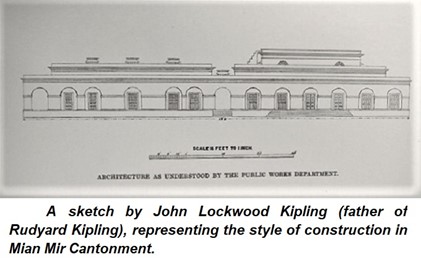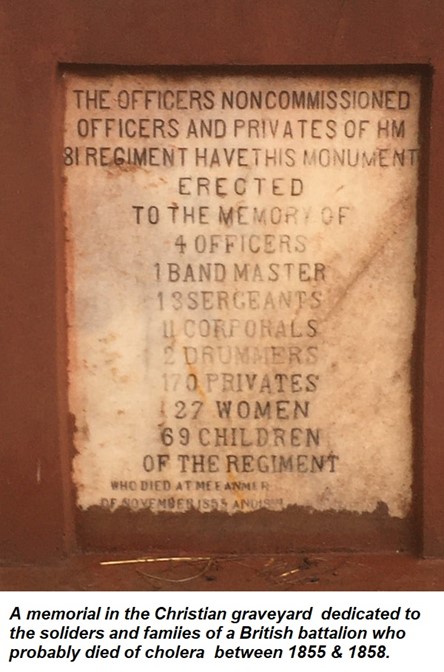

The Native Cavalry Lines were at the southern end of the cantonment and the open space where the cavalry trained came to be called Cavalry Ground. This large expanse of the Cavalry Ground was also used for growing fodder for the horses. It took three years to construct the church which was considered to be probably the most beautiful garrison church in India. The entire interior walls appear to be covered with marble and this effect has been created with mortar made from marble obtained from old buildings in Lahore. To the victors go the spoils.
Shortly after Mian Mir was occupied, the British pulled through an impending crisis in the cantonment with foresight. In 1857 the troops in the cantonment had been reduced by a third and there was only one British battalion and two troops of British Horse Artillery. When news arrived of the uprising in Meerut, in an emergency meeting in the Mian Mir Cantonment, Robert Montgomery, the Deputy Commissioner of the Punjab, was clear that “If Lahore is saved, the Empire is saved”. According to an informant, the four Native battalions and a cavalry regiment were preparing to mutiny and after much debate it was decided to disarm the Sepoys at the parade ground, where today stands the Fortress Stadium. Early in the morning of 15 May 1857, 2,500 Native Sepoys while on parade were surrounded by 600 British soldiers and 12 cannons ready to fire and laid down their weapons. 282 sepoys of the 26th Bengal Native Infantry mutinied later, killed some of their officers and escape under cover of a dust storm. They were intercepted and imprisoned in Ajnala and subsequently many were killed. Recently their remains have been found in a local well that had been filled with charcoal and lime.
As the garrison at Mian Mir recovered from the storm of 1857, they had to face a crisis of a different kind. When the troops moved out of the area of Anarkali the general state of health had improved and Mian Mir was frequently described as “ordinarily a very healthy station.” Sir Charles Napier was of the view that, “It is a healthy spot: good water is found 20 feet [6 meters] under the surface, and the air is pure.” Major General Windham who was commanding the Lahore Division in 1860 attributed the healthiness of the neighboring population to the dry climate and stated that commanding officers and medical officers considered that the health of the troops improves on coming to this station. Statistics supported these opinions since the death rate to cholera at Mian Mir of 30 per 1000 was half of that amongst British troops throughout India.

A year later all that changed with a severe cholera epidemic in Mian Mir. The cantonment acquired the reputation of ‘that plague spot’ that persisted for years and no regiment went to Mian Mir without the dread that they may too become victims of a similar fate as befell the British residents of this cantonment in August 1961. There were 2,452 European men, women and children in Mian Mir and in the course of six weeks nearly 900 of them were attacked by cholera, and more than 500 died.
The reason was partly related to the flow of workers and traders and provisions from the city and surrounding villages, which carried diseases. However, a bigger reason was much closer. If the barracks were satisfactory, the same could not be said of the drainage. The water from the wash-houses flowed into cesspits close to the barracks and sometimes overflowed. A sanitary report of 1860 states that they were only occasionally opened and emptied. They were located 30 to 40 meters from the well and contaminated the very same water that Napier considered good. To add. to the horrors, hospital accommodation was totally inadequate to meet even the ordinary requirements, and that from dread of admission men neglected to report their illness.

Lying alongside those suffering from cholera were patients admitted with ailments cause by excessive drinking. This was a serious problem amongst British troops and in some stations it contributed as much as one-sixth of the total admissions. Enormous profits were made on this sale of spirit and since any balance in the canteen fund of over Rs. 3,000 lapsed to Government, the surplus was spent but sadly not on improving the hospitals and the health of troops. Instead this money was used in many garrisons including Mian Mir to construct racquet courts, fives courts, swimming baths, theatres, etc. Gradually cholera was brought under control by improving the sanitation in the cantonment but what made a marked difference was establishing waterworks in 1873 for the supply of clean drinking water. In addition, the drinking water of British troops was filtered and boiled.

With the growth of the avenues of trees planted along the roadside, the dry dusty plain on which Mian Mir had been constructed gradually turned green. The author William J. Glover credits the British planners in India with creating “…a garden city built half a century before this concept of planning became popular in England”. However, this came at a huge price. In 1867, channels from the Bari Doab Canal (which after Independence was renamed as the Lahore Canal), were extended into the cantonment from the east for irrigating 1,200 acres (60 squares). This led to the accumulation of stagnant water specially when the canal water was diverted elsewhere. Within two years, the number of cases of fever had doubled from 800 cases to 1700 cases. In 1879 the number of cases was 3,427 per thousand indicating that on an average every man was admitted into hospital over three times in a season.
The authorities were unaware of the correlation between the stagnant water and fever because it wasn’t till the turn of the 19 century that Ronald Ross who worked in the Presidency General Hospital in Calcutta established that the fever was cause by malaria which was transmitted by mosquitos that bred in stagnant water. Apparently there was so much stagnant water in the cantonment, that it was overgrown with trees and shrubbery. After revisiting Mian Mir in 1873, Sir W. McMurdo, who had been Napier’s aide-de-camp, wrote, “I did not know the place again; it was all so crowded by extended vegetation which ought never to have been permitted.” Unaware of the cause of fever, efforts were directed towards improving the barracks, diet, clothing and general surroundings of the soldiers. However, the case of fever did not reduce. Even a year’s posting in Mian Mir was sufficient to render regiments unfit. So much so that when the time came for their relief, often not a single company was fit to march and the whole regiment had to travel by train. With every effort to combat the fever having failed, the authorities were so hopeless that it was almost decided that British troops should abandon the station.

In 1901, one last effort was made that for the first time focused on anti-malarial operations and obliterating the breeding-places of mosquitoes around the Royal Artillery lines. The results were dramatic. The admission-rate for malaria fell from 1,400 in 1901 to 300 in 1902. A more ambitious program was undertaken in 1904 under the direction of the GOC, of the Lahore Division, Lt. Gen. W. Kitchener whose brother was C-in-C of the British India Army. The canal was also diverted and by 1905, all canal irrigation within the cantonment boundaries had ceased. So intensive were the anti-malarial measures that by 1907, the admission rate had plunged to 200 per 1,000. It was just in time because Mian Mir had become so notorious that there were outcries in the British Parliament. In fact, in 1906 its name was changed to Lahore Cantonment and it was now possible to truthfully respond to members of the parliament by saying that the army was no longer quartered at the unhealthy Mian Mir Cantonment but at the Lahore Cantonment. The name Mian Mir Cantonment ceased to exist.
3 Comments
Your comment is awaiting moderation.
[…] The Lahore Cantonment of Mian Mir […]
Your comment is awaiting moderation.
[…] The Lahore Cantonment of Mian Mir […]
Your comment is awaiting moderation.
[…] The Lahore Cantonment of Mian Mir […]
Your comment is awaiting moderation.
[…] The Lahore Cantonment of Mian Mir […]
Your comment is awaiting moderation.
ремонт принтеров hp вао [url=https://www.servis-hp-moskva.ru/]https://servis-hp-moskva.ru/[/url]
Your comment is awaiting moderation.
сервисный центр hp [url=https://hp-servis-msk.ru]hp сервисный центр москва[/url]
Your comment is awaiting moderation.
обслуживание бойлеров [url=https://www.fix-boiler-moskva.ru/]https://fix-boiler-moskva.ru/[/url]
Your comment is awaiting moderation.
[…] The Lahore Cantonment of Mian Mir […]
Your comment is awaiting moderation.
[…] The Lahore Cantonment of Mian Mir […]
Your comment is awaiting moderation.
[…] The Lahore Cantonment of Mian Mir […]
The text flows with an organic, reflective cadence, allowing ideas to unfold naturally. Each sentence supports a contemplative reading experience, inviting attention, thought, and immersive engagement.
Thanks so much. greatly appreciated
Great Article